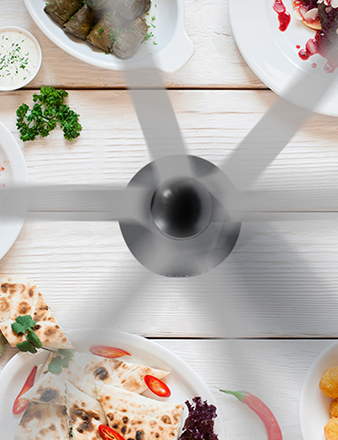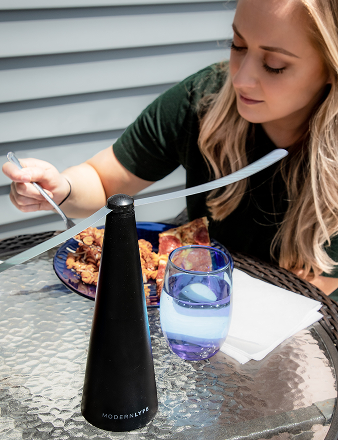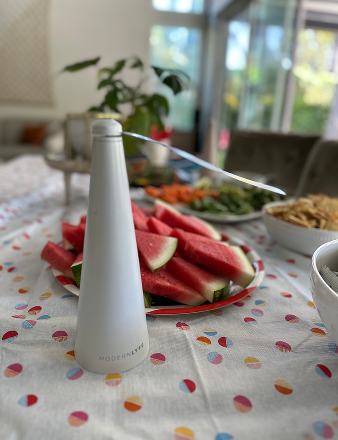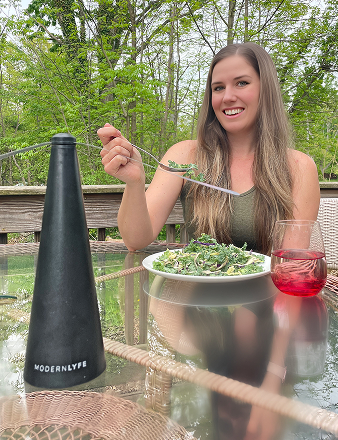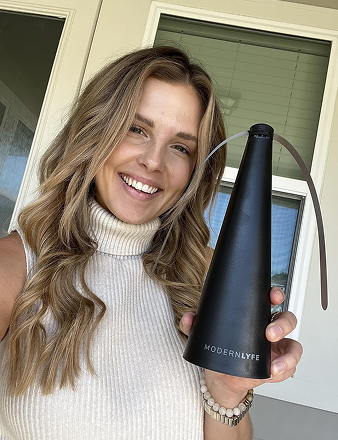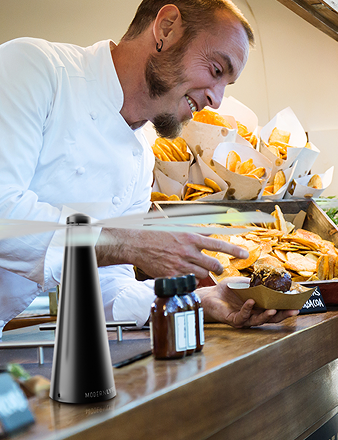When you're dealing with a fruit fly invasion, you need a solution that works—fast. The best fruit fly trap depends on your problem. For a full-blown infestation, a powerful UV light trap provides around-the-clock control. For a few stragglers, a simple liquid bait trap is often all you need for discreet, effective trapping.
Choosing the Right Fruit Fly Trap
Finding the right trap means matching it to your environment and the scale of your fly problem. A swarm around your compost bin needs a different plan than a couple of flies over the sink. Understanding the core differences between traps is the first step to getting your space back.
The goal isn't just to pick something that works, but something practical. Consider where you'll put it, the upkeep required, and whether it's safe around kids or pets.
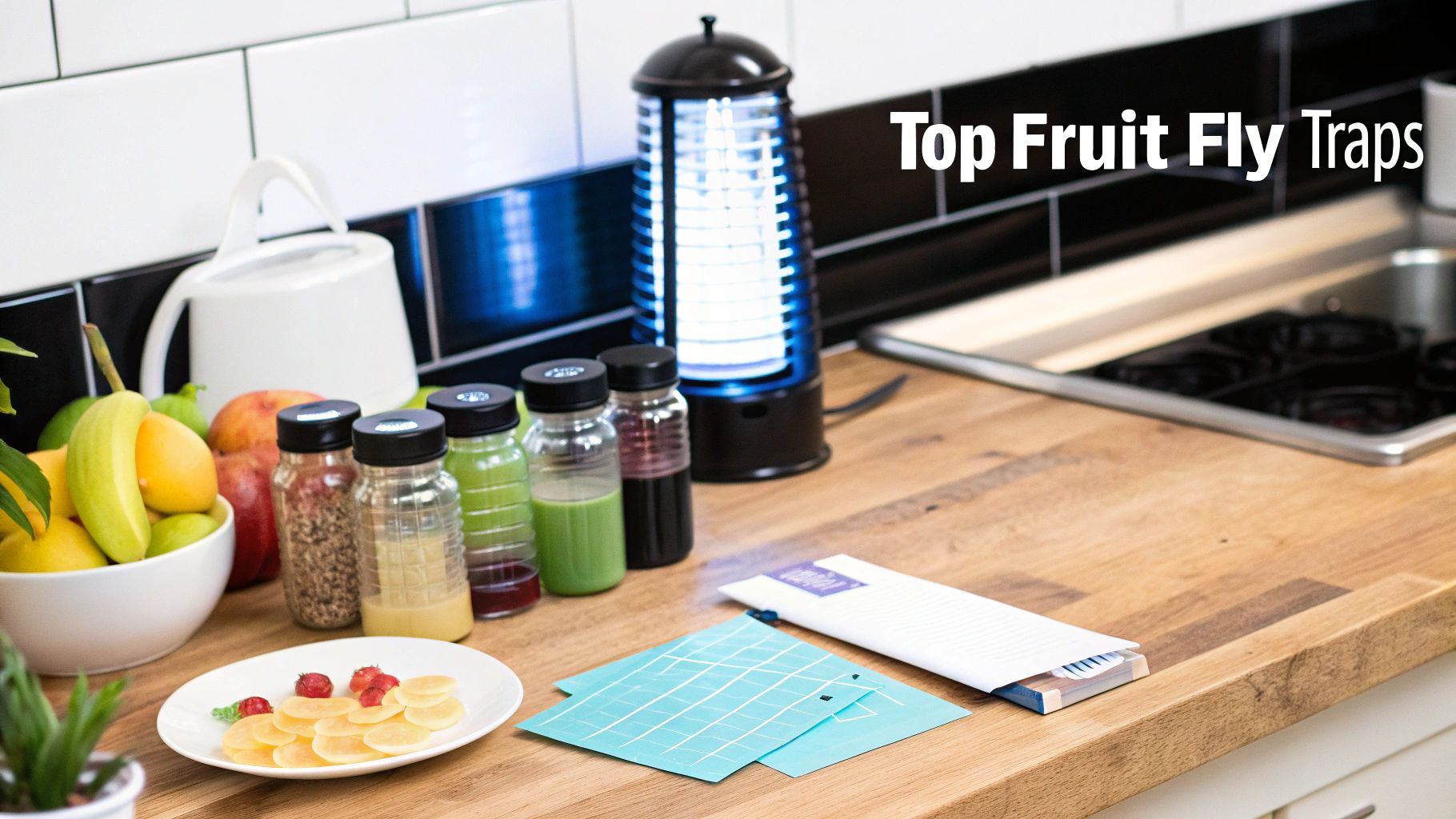
Key Decision Factors
Before you buy, think through these key points:
- Trap Type: Do you need a disposable sticky trap, a reusable liquid bait trap, or a heavy-duty electric UV model? Each has its place.
- Placement: Pinpoint the source of the problem. Is it near food prep areas, the garbage can, or indoor plants?
- Effectiveness: How bad is the infestation? Are you fighting dozens of flies or just catching a few before they multiply?
To help you narrow down the options, here’s a quick comparison of top-rated fruit fly traps. This gives you a solid starting point for finding the right fit.
Top Fruit Fly Traps at a Glance
This comparison helps you choose the right fruit fly trap for your specific needs.
| Trap Model | Best For | Effectiveness Rating (1-5) | Maintenance Level |
|---|---|---|---|
| Terro Fruit Fly Trap | Kitchen counters and near sinks | 4.5 | Low (Disposable) |
| Katchy Indoor Insect Trap | Large rooms and persistent issues | 5.0 | Medium (Requires electricity) |
| Aunt Fannie's FlyPunch | Discreet placement near fruit bowls | 4.0 | Low (Disposable) |
| Safer Home Indoor Plug-In | Outlets in kitchens and pantries | 4.2 | Low (Requires electricity) |
Each of these traps is a solid solution, but the best one depends on your situation. Whether you need something discreet for the countertop or a powerful trap for a bigger problem, matching the trap to the job is key.
How Different Fruit Fly Traps Actually Work
To find the best fruit fly trap, you need to know how they get the job done. It's not magic—it's science. Different traps use unique methods to attract and capture these pests, and the right one depends on your situation. Let’s get past the marketing hype and look at the mechanics behind the three most common types.
Each design is engineered to exploit a specific weakness in fruit fly biology. Once you understand how they work, you can choose a trap with confidence.
Adhesive Traps: The Sticky Solution
Adhesive traps, or sticky traps, are as straightforward as it gets. They typically feature a bright color like yellow, which naturally attracts many flying insects. The surface is coated with a powerful, non-toxic glue that stops any fly the moment it lands.
Their success lies in simplicity and smart placement. These traps are most effective when placed directly in the flight paths of fruit flies—near the kitchen sink, above the fruit bowl, or next to the compost bin. They're a passive, silent, and chemical-free way to handle a minor fruit fly problem.
Key Insight: Sticky traps don't call flies from across the room. Their power is interception. Place them within inches of a problem spot to catch flies where they live and breed.
Liquid Bait Traps: The Lure and Drown Method
Liquid bait traps work on a simple principle: attract, trap, and drown. They use a potent liquid lure, usually vinegar-based, that smells like the fermenting fruit that fruit flies can't resist. Once they fly into the trap, they can't escape the liquid and drown.
This method is popular because it targets the fruit fly's incredible sense of smell, drawing them away from the actual fruit on your counter. Many of the best DIY solutions are based on this exact concept. For a deeper dive into what makes a good bait, this fruit fly catcher guide breaks down the options.
UV Light Traps: The Modern Approach
For an active pest control strategy, look no further than modern UV light traps. These electric devices use a specific wavelength of ultraviolet light that fruit flies and other pests find irresistible. Once they get close, they're either caught on a hidden sticky pad or sucked into a holding chamber by a quiet fan.
These traps are ideal for larger rooms or more serious infestations. They work 24/7, offering constant protection without chemical baits or smells. Their biggest advantage is their range; they can pull in flies from all corners of a room, making them a powerful tool for stubborn fruit fly issues.
A Head-to-Head Comparison of Fruit Fly Trap Technologies
Picking the right fruit fly trap isn't just about grabbing the first one you see. You have to match the tool to the job. A trap that excels in a dry pantry might be a dud in a steamy kitchen. What works for a small apartment won't touch an infestation in a bustling restaurant.
The decision comes down to performance, safety, and long-term cost. That high-powered UV zapper might look impressive, but it isn't always the smartest move for your kitchen counter. Sometimes, a discreet liquid trap by the sink does a much better job without getting in the way.
This infographic breaks down the mechanics of the three most common trap types at a glance.
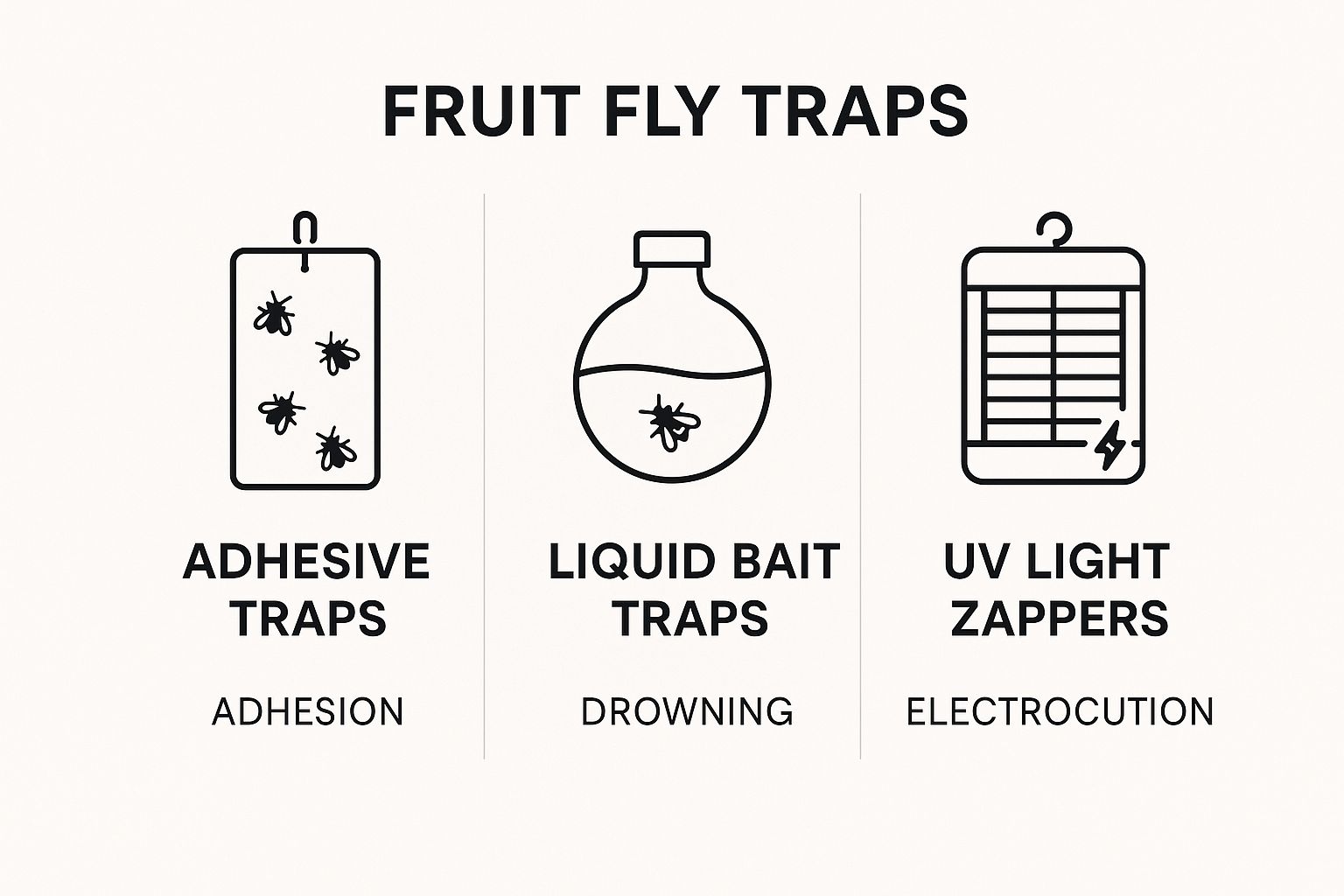
As you can see, each one uses a different strategy—stickiness, drowning, or capture—to get the same result. Knowing how they work is the first step to figuring out which one you need.
Performance in Different Environments
A fruit fly trap's success is tied to its surroundings. Humidity, air currents, and other smells in the room can make or break its effectiveness.
-
Liquid Bait Traps: These are best in still air, like near a kitchen sink, in a pantry corner, or behind a coffee maker. Their power comes from the attractant's scent, and a strong draft can scatter it, making the trap invisible to flies. They're a fantastic, low-profile choice for zeroing in on problem spots. You can dive deeper into placement strategies with our guide to using a liquid fly trap effectively.
-
Adhesive Traps: Known as sticky traps, their strength is interception. Place them directly in the flies' flight path, like along the edge of your compost bin or over the fruit bowl. Be aware that the glue can lose its stickiness in dusty or greasy places, like a busy commercial kitchen.
-
UV Light Traps: These electric models are the heavy hitters for bigger, open areas. They shine in living rooms, garages, or restaurant dining rooms where they can pull in flies from across the space. Because they use light instead of scent, they aren't competing with food smells, making them a solid option for widespread infestations.
Trap Technology Showdown
Let's break down how these three technologies stack up feature by feature. This table gives you a quick snapshot of their pros and cons.
| Feature | Liquid Bait Traps | Sticky Traps | UV Light Traps |
|---|---|---|---|
| Primary Attractant | Scent (e.g., vinegar) | Visual (color/shape) | Light (UV spectrum) |
| Best For | Kitchens, pantries, targeted areas | Near fruit bowls, compost bins | Large rooms, open spaces |
| Maintenance | Refill liquid every few days/weeks | Replace when full | Replace bulb/pad annually |
| Safety Concerns | Low; often non-toxic | Low; chemical-free glue | Moderate; electrical components |
| Upfront Cost | Low | Very Low | High |
| Ongoing Cost | Moderate (refills) | High (frequent replacement) | Low (electricity, occasional parts) |
| Discreetness | High | Moderate | Low |
Each trap has its place. Weigh these factors to decide which one aligns with your situation and tolerance for maintenance and cost.
Safety and Household Considerations
If you have kids or pets, safety is a top priority. You need a trap that works without becoming a household hazard.
Liquid traps are often the safest bet, as many use simple, food-safe ingredients like apple cider vinegar. Sticky traps are also a great choice, typically relying on non-toxic glue.
The biggest safety trade-off usually comes with UV traps. While they don't use chemicals, some models have an open "zapping" grid. You have to be smart about placement, keeping them well out of reach of curious hands or paws. Newer designs often enclose the zapper or use internal sticky pads to make them much safer.
Analyzing Long-Term Cost of Ownership
Don't just look at the shelf price. The real cost of a fruit fly trap includes everything you'll spend over its lifetime, from refills and replacement pads to electricity.
UV light traps have the highest initial cost but are cheap to run. Aside from swapping a bulb or sticky pad annually, their impact on your electricity bill is minimal. On the other hand, disposable liquid and sticky traps are cheap upfront, but you have to keep buying them, and those costs can add up.
This economic model is why the global fly trap market is projected to hit USD 623 million by 2030. People are investing in solutions that work, and the market is growing to meet that demand. You can dig into the numbers in this comprehensive fly trap market report.
Matching the Right Trap to Your Space
Choosing the best fruit fly trap means finding the right tool for the job. The heavy-duty trap that works in a restaurant kitchen is overkill for a small apartment. It's all about context.
The goal is to pick a trap that fits your environment while being lethal to pests. For homeowners, this means something safe and discreet. For a business, priorities shift to raw power, capacity, and health code compliance. Let's look at the best choices for these different settings.
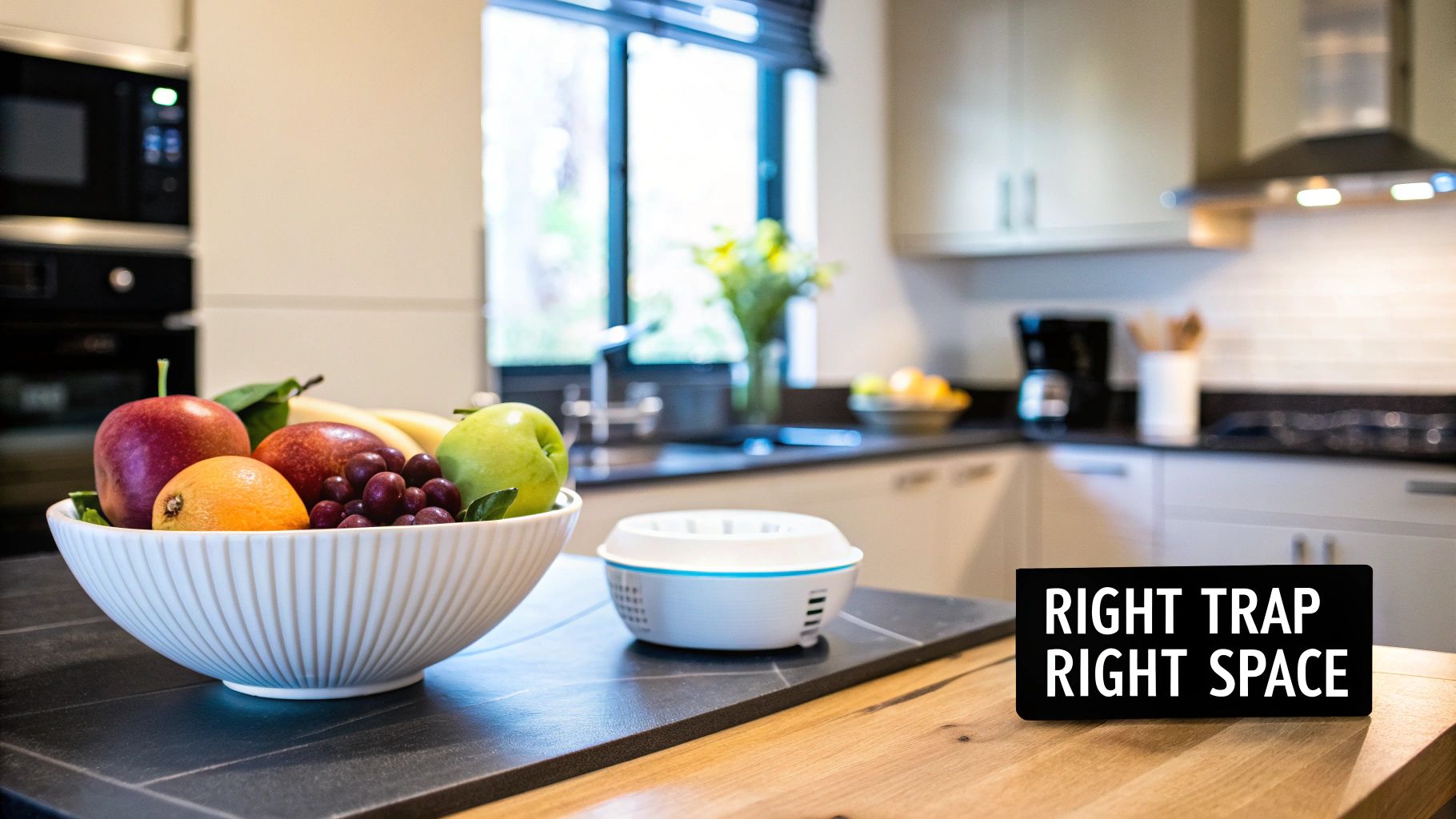
Solutions for Home Environments
At home, you need something that gets the job done without being a centerpiece. Safety is paramount, especially with kids or pets around.
-
Kitchens and Food Prep Areas: This is the main battleground. A subtle, non-toxic liquid bait trap is your best bet. Set it near the fruit bowl or sink where flies gather, and its lure will pull them away from your food.
-
Near Indoor Plants and Compost Bins: Don't forget other hotspots. Moist soil in planters and kitchen compost pails are fruit fly nurseries. Adhesive traps are perfect here. Pop them into the soil or stick one on the compost bin to catch flies where they breed.
-
Living Rooms and Bedrooms: If the problem has spread, a sleek UV light trap with a hidden sticky pad is a fantastic, set-and-forget solution. These plug-in models often look like nightlights or air purifiers, blending in while working 24/7.
High-Capacity Traps for Commercial Settings
In restaurants, bars, or grocery stores, a fruit fly infestation is more than an annoyance—it can hurt your bottom line and reputation. Here, the game changes to high-capacity, robust traps built for a bigger fight and designed to meet health standards.
Crucial Consideration for Businesses: Commercial traps need to be powerful enough for a serious fly population yet subtle enough not to bother customers. Placement is strategic—you want maximum impact in the back-of-house without being an eyesore in the dining room.
The most effective commercial plans use a multi-pronged attack. A large UV light trap is essential for kitchens, storage rooms, and loading docks, giving you continuous, wide-area coverage. These are industrial-strength units made to withstand a commercial environment.
For customer-facing spots like bar counters or produce aisles, a series of smaller, strategically placed liquid traps can tackle localized flare-ups. To get the most out of your setup, learn how to properly set up a fly trap with bait for maximum attraction. This layered approach ensures your pest control is both relentless and invisible to clients.
Advanced Solutions for Persistent Infestations
So, you’ve tried standard traps, but the fruit flies keep coming back. When a small annoyance becomes a stubborn infestation, it's time for the heavy hitters. For relentless fruit fly problems, particularly in commercial or agricultural spaces, advanced solutions offer a more scientific and powerful line of defense.
These systems go beyond simple vinegar lures. They often rely on pheromones—highly specific chemical signals that fruit flies can't resist. This targeted approach is a core principle of modern integrated pest management (IPM) because it lets you zero in on the pest without collateral damage to beneficial insects or the environment.
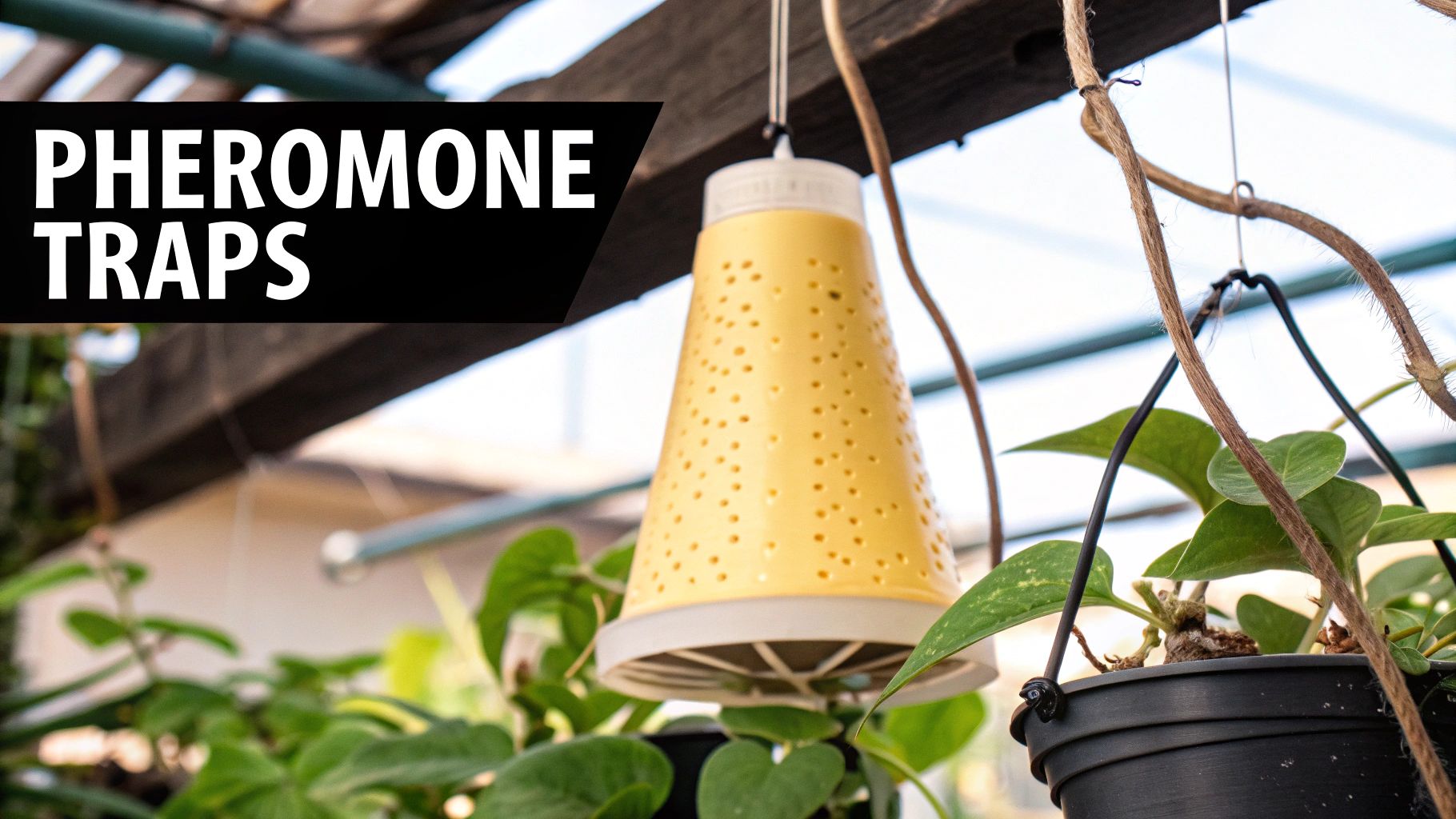
This precision is why pheromone traps are the go-to choice in places where you can't spray chemicals, like orchards, vineyards, and organic food facilities. They offer a sustainable way to get populations under control.
The Power of Pheromone Technology
Pheromone traps hijack the fruit flies' own communication system. They release a synthetic version of the chemicals flies use to find mates, creating a lure far more potent than simple bait, drawing them in from a much wider area.
This technology is taking off. In 2024, the global market for fruit fly pheromone traps was valued at over USD 421 million and is expected to pass USD 1 billion by 2033. The driver? A massive consumer shift toward chemical-free produce and the need to reduce pesticide use. This trend makes pheromones a critical tool for any business focused on eco-friendly practices, as detailed in this fruit fly pheromone market analysis.
Key Takeaway: Pheromone traps offer a highly targeted, eco-friendly solution for tough infestations. Their ability to attract only fruit flies makes them perfect for sensitive areas where you need to protect other species.
When dealing with a large-scale or deep-rooted infestation, investing in an advanced trap isn't just an expense—it's a strategic move.
When to Choose an Advanced Trap
Let's be clear: a pheromone trap is overkill for a few flies around your fruit bowl. But in certain situations, they provide a decisive advantage.
- Commercial Kitchens and Bars: In any food service business, a fruit fly problem can quickly become a health code violation or a ruined reputation.
- Agricultural Settings: These traps are essential for protecting crops in farms, orchards, and greenhouses without coating produce in chemical sprays.
- Persistent Home Infestations: If you've tried all the DIY tricks and the flies won't leave, it might point to a hidden breeding ground. A powerful lure can help you manage the population while you find the source.
Choosing an advanced trap means escalating your response to match the severity of the problem. For serious infestations, they deliver a sustainable, effective, and targeted solution that standard traps can't match.
Alright, let's cut to the chase. After digging into the tech and putting these traps head-to-head, it’s time to pick the winners. I've sifted through the data to give you my top recommendations, matching the right trap to the right problem so you can get these pests out of your space.
These picks aren't just about what works, but what works best for specific situations. I've weighed everything—power, ease of use, safety, and cost—to give you clear guidance. The goal is simple: help you buy the right trap and solve your fruit fly problem for good.
Best Overall Performance: Katchy Indoor Insect Trap
If you're looking for a workhorse that handles more than just fruit flies, the Katchy Indoor Insect Trap is my go-to. It’s a triple-threat system: a UV light draws them in, a silent fan sucks them down, and a sticky pad ensures they don't leave. This device is built to clear out larger areas effectively.
Yes, the initial price is higher, but for its low-maintenance design and ability to catch gnats and other small fliers, it’s a solid investment for anyone with a persistent pest problem. It’s perfect for open-concept kitchens, living rooms, or small commercial spaces where you need quiet, continuous control without chemical baits.
Top Budget-Friendly Option: Terro Fruit Fly Trap
Sometimes you just need something fast, cheap, and effective. That's where the Terro Fruit Fly Trap shines. It's a classic for a reason. The apple-shaped container uses a liquid lure that fruit flies can't resist. You pop it open, set it on the counter, and forget about it.
It's a fantastic choice for zeroing in on hotspots like the kitchen counter, the area around the sink, or right next to a tempting fruit bowl.
This trap’s real advantage is its focused simplicity. It’s not designed to clear your whole house, but for targeted takedowns where fruit flies gather, you won’t find better performance for the price.
Most Discreet for Kitchens: Aunt Fannie's FlyPunch
For those who want a trap that doesn't scream "I have a pest problem," Aunt Fannie's FlyPunch is the hands-down winner. The small, subtle container blends into your kitchen decor, and the bait is made from food-safe ingredients. It’s the one you can confidently place near food prep areas without it being an ugly distraction.
The all-natural formula is a huge plus, especially if you have kids or pets. It’s proof that you don't need to choose between style and function. Just set it out where you see the flies, and it will quietly and effectively get the job done.
Common Questions About Fruit Fly Traps
Even with the perfect trap, you might wonder how to get the best results. A little know-how can make a massive difference. Let's tackle some of the most common questions with clear, practical answers.
Think of these as insider tips to get the most out of your trap and keep your space pest-free.
Where Should I Place My Fruit Fly Trap?
Placement is everything. You have to think like a fruit fly and put the trap where they hang out. The goal is to intercept their flight path or set it up near their food and breeding spots.
Here are a few prime locations:
- Near fruit bowls: This is the most obvious choice for a reason—ripening fruit is a magnet for them.
- Next to the kitchen sink: Drains are notorious for collecting the gunk that fruit flies love.
- Beside compost bins or garbage cans: These are five-star resorts for fruit flies, so a trap here is a must.
One thing to avoid? Don't place traps in drafty spots. A steady breeze can scatter the bait's scent, making it much harder for flies to find it.
How Long Until My Trap Starts Working?
You'll need a little patience, but not much. Most traps, whether liquid or sticky, will start catching flies within a few hours. By the next morning, you should see results.
A trap's power kicks in over time. While it starts working right away, give it 2-3 days to make a serious dent in the population, especially if you're dealing with a full-blown infestation.
UV light traps are different—they get to work the second you plug them in, offering 24/7 protection. If you haven't seen any action within a day, try moving the trap to a new spot.
What Can I Do to Make My Trap More Effective?
Traps are fantastic, but they work best as part of a larger strategy. Managing organic waste is the secret to long-term fruit fly control. You can learn more about eliminating their breeding grounds with effective home composting methods.
On top of that, cut off their food supply. Keep your counters clean, put ripe fruit in the fridge, and take your trash out regularly. The cleaner your kitchen, the fewer places flies have to multiply, making your trap's job much easier.
Ready to create a comfortable, pest-free zone for your family or customers? Explore MODERN LYFE's line of elegant fly fans and take control of your space today. Visit us at https://modernlyfe.com to find the perfect solution.

